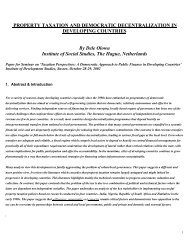View Article - Institute of Development Studies
View Article - Institute of Development Studies
View Article - Institute of Development Studies
Create successful ePaper yourself
Turn your PDF publications into a flip-book with our unique Google optimized e-Paper software.
38(nominated or elected) members from the GP, the person or persons securing the secondhighest votes in the preceding panchayat election (that is to say, members from the oppositionparty), members from NGOs and other community based organisations, from self-helpgroups functioning in the area, serving or retired government employees in the area, servingor retired teachers. At least 40 percent <strong>of</strong> the members shall be women. Far from being apolitically settled issue, the constitution, composition and functions <strong>of</strong> the Council are stillvery much at the centre <strong>of</strong> public debate. Only recently some government orders have beenissued to facilitate the operationalisation <strong>of</strong> the project <strong>of</strong> planning from below, involvinglocal development experts and the people at large.Three distinct responses to the current drive for creating the GUS are in circulationnow in the State, ranging from a laudatory, to sceptical, to an overtly critical overtone.Some commentators view this recent legislative initiative as a welcome extension <strong>of</strong> thelowest tier <strong>of</strong> self-governance in order to ensure greater transparency and accountability indevelopmental activities – ‘as a bold step towards open direct participatory democracy’.The idea is, so the laudatory view holds, not to create another ‘mini panchayat’ and therebysubstitute ‘people’s representation’ for ‘people’, but to move away from representationbaseddemocracy to people-centred direct democracy. A more sceptical reading <strong>of</strong> thelatest legislative initiative invites us to recall the experience <strong>of</strong> the programme <strong>of</strong> theConvergent Community Action (CCA) – introduced by the Government <strong>of</strong> West Bengal in1986 in the district <strong>of</strong> Medinipur. The current proposal, some argue, is just a new ‘avatar’<strong>of</strong> the old CCA movement – village planning by the villagers, with an accent on mobilisationand utilisation <strong>of</strong> local productive forces, the achievement record <strong>of</strong> which is mixed atbest. Hence the question, “Why is it being revived by giving it some other name?”(Chatterjee, 2003, p.4091).A stronger critique is waged against the latest Amendment Act on the ground thatadditional rounds <strong>of</strong> decentralising exercise <strong>of</strong>ten lead to unnecessary institutionalproliferation, which leaves new institutional vestiges without making any substantivedifference to the functioning <strong>of</strong> the existing regime. Bandyopadhyay (2003b), for example,argues forcefully that legislation is creating tier after tier <strong>of</strong> non-functional PR bodies,without funds, functions, and functionaries. Instead <strong>of</strong> empowering the GP, he continues,the amending act makes it more ‘dysfunctional’. Indeed, the Act is not very clear about thekind <strong>of</strong> relationship that it envisages between the GP and the GUS, or for that matter withthe State government. Is there any overarching authority that can supersede the Council?





